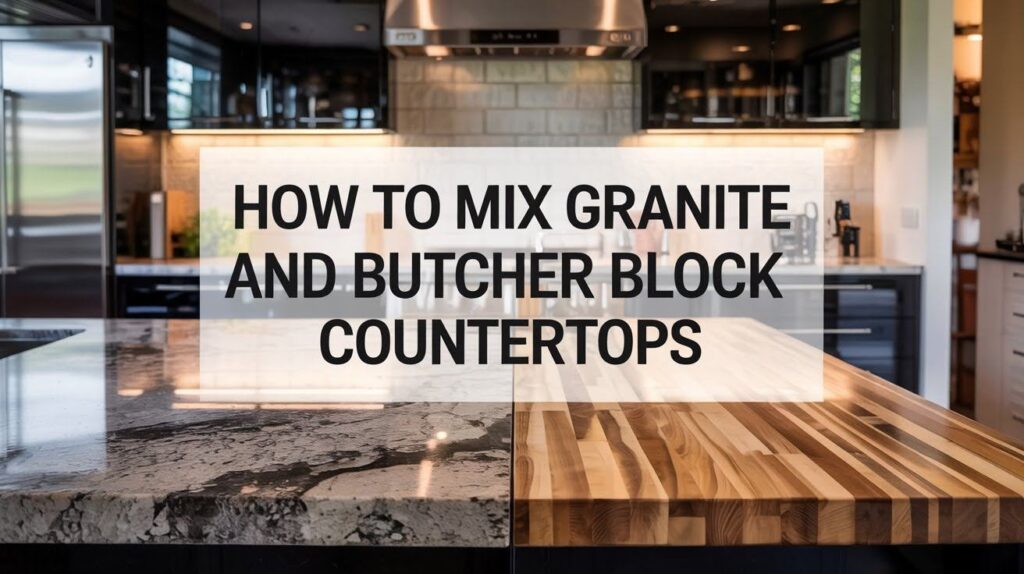I’ve seen countless kitchens change dramatically when homeowners mix different countertop materials. It’s become one of my favorite design trends.
Granite and butcher block create an amazing combination. You get the strength and luxury of stone paired with the warmth and character of wood. This mix works because each material has different strengths.
Granite handles heat and moisture like a champion. Butcher block brings natural beauty and a softer feel.
In this guide, I’ll show you exactly how to make this combination work. You’ll learn the best layouts, color combinations, and installation tricks. Plus, I’ll share the mistakes that can ruin the whole look.
Most homeowners stick with one material because they think mixing is too complicated. But it’s simpler than you might expect. The key is understanding which material works best in each zone.
Understanding Granite Countertops
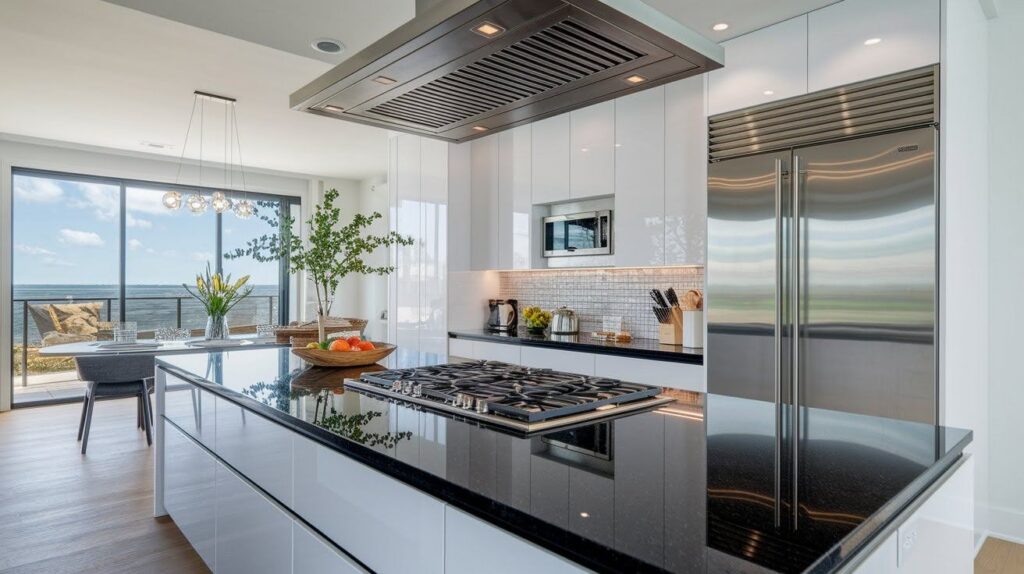
Granite brings serious durability to your kitchen. It’s nearly impossible to scratch or chip with normal use.
The surface stays cool, which makes it perfect for rolling pastry or working with chocolate. Heat from pots and pans won’t damage it either.
Ideal zones for granite include:
- Around the stove and cooktop
- Near the sink and dishwasher
- High-traffic prep areas
- Anywhere you need maximum durability
Popular granite colors that work well with wood:
- Black granite (pairs with any wood tone)
- White or light gray granite (classic with walnut or cherry)
- Beige or tan granite (complements oak and maple)
- Dark gray granite (beautiful with light woods)
The key is choosing granite that won’t compete with your wood choice.
What Makes Butcher Block a Great Pairing
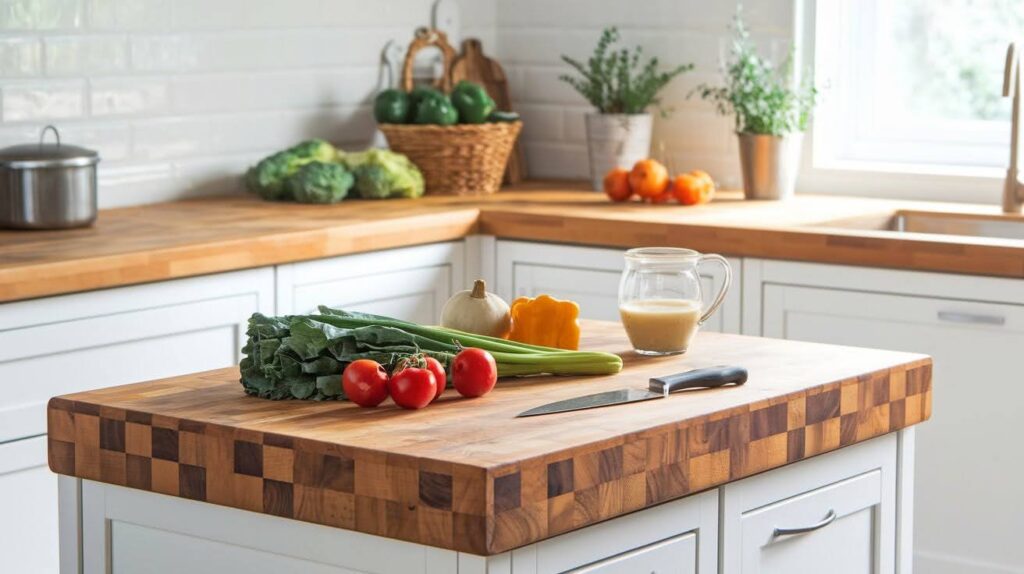
Natural wood brings warmth that stone simply can’t match. It softens hard lines and adds organic texture.
Butcher block excels in prep zones, islands, and breakfast bars. It’s easier on your knives than stone. Plus, minor scratches and dings actually add character over time.
Maintenance basics:
- Oil your butcher block monthly with food-safe mineral oil
- Clean with mild soap and warm water
- Sand out deep scratches when needed
- Never soak wood surfaces
Ideal locations for butcher block:
- Kitchen islands
- Breakfast bars
- Baking stations
- Areas away from the main sink
The natural movement of wood actually helps it last longer by preventing stress cracks.
Best Layout Ideas for Mixing Granite and Butcher Block
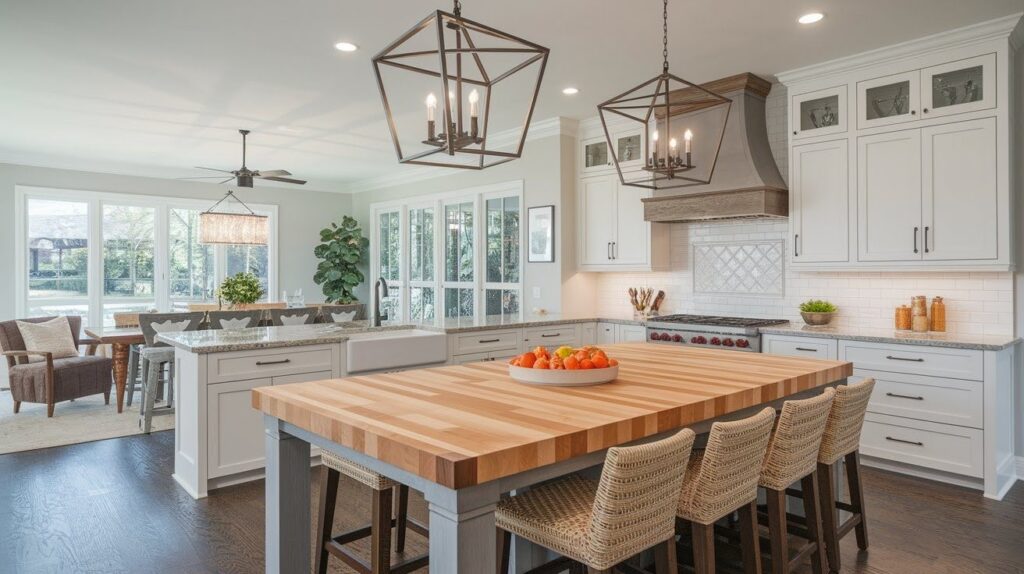
U-shaped kitchen with island: This is my go-to layout. Put granite on the perimeter for durability. Use butcher block on the island for warmth and contrast. The island becomes a focal point while the granite handles the heavy-duty work zones.
L-shaped kitchen with breakfast bar: Run granite along the main counters. Add butcher block for the breakfast bar extension. This creates a clear separation between work and casual dining areas.
Zoned design approach: Think about how you actually use your kitchen. Put granite near the cooktop and main sink. Use a butcher block for your main prep station and any secondary sink areas.
This method focuses on function first, style second. The result? A kitchen that works as well as it looks.
Choosing Complementary Colors and Finishes
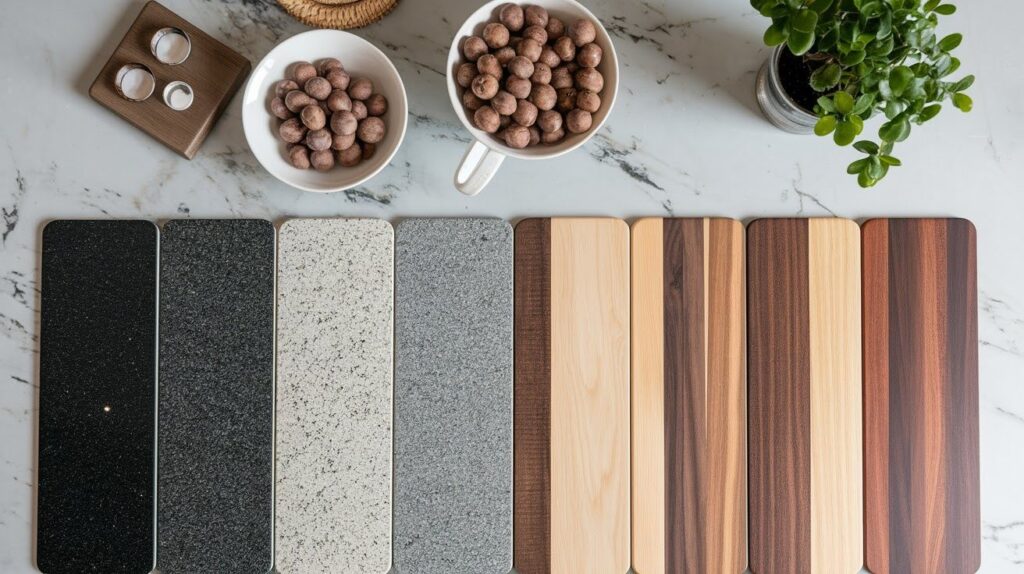
Color harmony makes or breaks this design approach.
Start with your dominant material first. If granite covers most of your counter space, choose wood tones that complement its color.
Winning combinations:
- Black granite + light oak butcher block
- White granite + rich walnut wood
- Gray granite + maple or hickory
- Beige granite + cherry or mahogany
Avoid pairing busy granite patterns with highly figured wood grains. One should be the star, the other should support.
Finish considerations:
- Polished granite works with any wood finish
- Matte granite pairs beautifully with satin wood finishes
- Leathered granite adds texture that complements natural wood grain
Test samples in your actual lighting before making final decisions.
Installation & Transition Tips
Smooth transitions between materials separate amateur from professional results.
Creating seamless transitions:
- Keep all surfaces at exactly the same height
- Use thin metal strips at material changes
- Consider waterfall edges where materials meet walls
- Align cabinet heights perfectly
Professional tricks:
- Install granite first, then fit butcher block to match
- Use color-matched caulk at all seams
- Plan electrical outlets to avoid awkward material breaks
- Consider how lighting will hit different surfaces
The goal is making two different materials look like they were always meant to be together.
Edge profiles matter too. Match the complexity level between materials. Simple edges on both, or detailed edges on both. Never mix a highly detailed granite edge with a simple wood edge.
Benefits of Mixing Countertop Materials
Mixing materials creates visual interest in ways that single surfaces can’t match.
Visual contrast and depth come naturally when you pair smooth granite with textured wood. Your eye moves around the space instead of getting bored.
Functionality by zone is another huge win. Different areas of your kitchen need different qualities. Your prep zone needs a surface that’s easy on knives. Your cooking area needs something that won’t crack under heat.
This approach adds custom and high-end appeal to any kitchen. It shows thoughtful planning instead of taking the easy route.
Most importantly? You can focus your budget on premium materials where they matter most.
Maintenance & Care for Mixed Countertops
Different materials need different care routines.
For granite surfaces:
- Clean daily with mild dish soap
- Reseal annually with stone sealer
- Use cutting boards to prevent dulling
- Wipe up spills immediately
For butcher block:
- Oil monthly with food-safe mineral oil
- Clean with soap and water, dry immediately
- Sand and re-oil when surface looks dry
- Use separate cutting boards for raw meat
Cross-contamination prevention:
- Never cut raw meat directly on butcher block
- Keep separate cleaning cloths for each surface
- Don’t let water pool on wood surfaces
- Clean granite with bleach solutions, wood with gentler cleaners
Set up different cleaning stations for each material type.
Common Mistakes to Avoid
- Using butcher block too close to sinks without proper sealing – Water damage happens fast with unsealed wood
- Picking two highly patterned surfaces that compete for attention – One busy surface, one calm surface works better
- Ignoring natural wood movement during seasonal changes – Wood expands and contracts with humidity
- Placing butcher block in high-heat zones – Hot pots will scorch and crack wood surfaces
- Mixing too many different wood species – Stick to one wood type for cohesion
- Forgetting about lighting effects on different surfaces – Test your combinations under actual kitchen lighting
- Skipping the sealing process on either material – Both granite and wood need proper protection
- Creating awkward transitions between materials – Plan your layout before installation begins
Conclusion
Mixing granite and butcher block creates kitchens with both beauty and smart function. You get the durability of stone where you need it most. Plus the warmth of wood where it makes the biggest impact.
The key is planning your zones carefully. Put granite in high-use areas that need maximum durability. Use a butcher block where you want warmth and visual interest.
Don’t be afraid to experiment with different textures and tones. Some of the best combinations come from unexpected pairings.
Start with samples in your actual space. Live with them for a few days. See how they look in morning light versus evening light.
Your kitchen should work for your lifestyle first. Style comes second. When you get both right, you’ll have a space that serves you well for decades.
The investment in mixed materials pays off in both daily enjoyment and home value.
Frequently Asked Questions
Can I install a butcher block and granite myself?
Granite requires professional installation due to weight and precision cutting needs. Butcher block is more DIY-friendly, but hiring pros ensures perfect alignment between materials.
How much does mixing these materials typically cost?
Expect to pay $40-80 per square foot for granite and $25-50 for quality butcher block. Mixed installations may cost 10-15% more due to additional transition work.
Will different expansion rates cause problems?
Proper installation accounts for material movement. Leave small gaps at transitions and use flexible sealants. Professional installers know how to handle these differences.
How often do I need to maintain each surface?
Oil butcher block monthly and reseal granite annually. Daily cleaning routines differ – use stone cleaners on granite and mild soap on wood surfaces.
What thickness should I choose for each material?
Standard thickness is 1.25 inches for both materials. This creates seamless transitions and provides adequate strength for both granite and butcher block surfaces.

